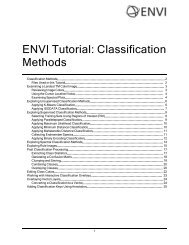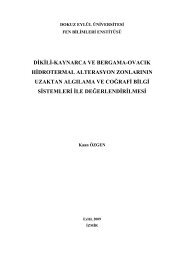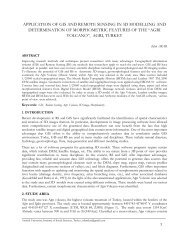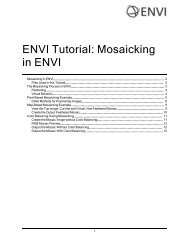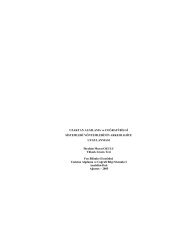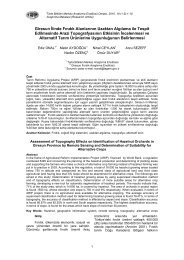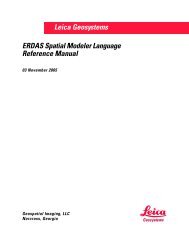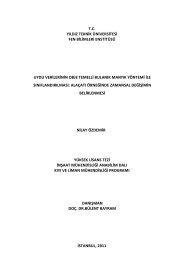Paper Title (use style: paper title)
Paper Title (use style: paper title)
Paper Title (use style: paper title)
Create successful ePaper yourself
Turn your PDF publications into a flip-book with our unique Google optimized e-Paper software.
Determination of Land Use Effects on Flood Risk byUsing Integration of GIS and Remote Sensingİrfan AkarMarmara UniversityDepartment of Middle East GeographyBeyazit, IstanbulTurkeyEmail: irfanakar@gmail.comKaan KalkanIstanbul Technical UniversityInstitute of ScienceMaslak, IstanbulTurkeyEmail: kalkaan@gmail.comDerya MaktavIstanbul Technical UniversityDivision of Remote SensingMaslak, IstanbulTurkeyEmail: maktavd@itu.edu.trYasemin ÖzdemirMarmara UniversityDepartment of GeographyGoztepe, IstanbulTurkeyEmail: ozdemiry@marmara.edu.trAbstract—The various human activities are one of the mainaffecting factors on natural disasters. Human effects not suitablefor land <strong>use</strong> potential can ca<strong>use</strong> both physical and moraldamages. Yeniçiftlik stream basin, located within the boundariesof Beykoz, a suburb of Istanbul in Turkey, has been selected asthe study area. It covers an area of 3.66 km 2 of the YeniçiftlikRiver within the boundaries of the Beykoz district.Nowadays, there are many methods for flood researches. Notonly new satellite technologies but also improvements of GISprovide important advantages in the researches of naturaldisasters. In this study, the effects of land <strong>use</strong> features on floodoccurrence have been determined by using GIS and remotesensing. Pixel-based classification method has been <strong>use</strong>d foranalyzing land <strong>use</strong> features. IKONOS pan-sharpened satelliteimagery has been <strong>use</strong>d for current land <strong>use</strong>. Processes of floodanalyze were performed by means of HEC-GeoRAS (ArcGIS 9.3)and HEC-RAS 4.0 (Hydrologic Engineering Centers RiverAnalysis System) hydraulic software. In this study, geometricdata composes the basis of the model. These data are rivers, rivercoasts, stream ways, cross sections and land <strong>use</strong>. The geometricdata of the study area are produced with HEC-GeoRAS and allother data were gathered here before they were transferred tothe HEC-RAS. After the input of the geometric data stream, datarelated to the basin where the modeling will be done were input.Hydraulic and hydrologic modeling for the flood risk studies,flood flow rates of 10, 50 and 100 years were calculated usingmaximum flood flow rates of 30 years, and flood risk maps wereobtained making hydraulic modeling according to the dataobtained.Keywords-Remote sensing, GIS, Land<strong>use</strong>, Flood.I. INTRODUCTIONEffects of a natural event on the human life are theimportant factors to characterize them as a disaster. In the viewof this information floods are the biggest natural disasters afterearthquakes. Floods are important natural disasters which ca<strong>use</strong>physical and moral damages and have a hydrographic origin.Important factor of flood occurrence near settlements iserroneous land <strong>use</strong> in these areas. It is clearer in developingand under-developed countries. Increasing population ratesca<strong>use</strong> uncontrolled and disordered settlements. It is alsoimportant that artificial human effects on hydrographicstructures ca<strong>use</strong> flood. Recent technologies help scientists tomake successful researches about floods. Especially GIS andRS are both important methodologies for flood researches. Inaddition to these two technologies hydrological softwares arealso <strong>use</strong>d in actively. In this study all of these methodologieswere utilized.II.STUDY AREAThe study area is located within the district boundaries ofBeykoz between 41°18’04’’ N, 41°14’55’’ S, 29°18 ’ 25’’ W,29°21’78’’ E. Yeniçiftlik stream basin has a perimeter of 33km and a surface area of 31.1751 km 2 ; the north–south lengthof the basin is 12.555 km, and the east–west length is 3.75 km.The study area covers an area of 3.66 km 2 of this basin (Fig.1).III.METHOD AND DATAData sources are 1:25000 scale digital terrain model (DTM),pan-sharpened IKONOS imagery (02.03.2008) and 1:5000scale aerial photos (26.06.2008). Current land <strong>use</strong> of the studyarea is determined by supervised classification of IKONOSimagery. Also aerial photos were <strong>use</strong>d to determine land <strong>use</strong>specifications and to create 3D model. DTM was <strong>use</strong>d in bothHecGEORAS (ArcGIS) and Hec-RAS software. Geometricdata of Yeniçiftlik River was created by using DTM. Steadyflow data of 30 years for Yeniçiftlik River is <strong>use</strong>d and 10-50-100 years flood estimations were produced in Hec-RASsoftware.
Figure 1. Location of the study area.A. Land<strong>use</strong> Characteristics and Hydrological RiskDetermination of up-to-date land <strong>use</strong> characteristics in theYeniçiftlik stream basin and data gathering were accomplishedwith the help of RS and GIS system technologies. A highresolutionIKONOS pan-sharpened image was classified withsupervised classification method using Erdas 9.1 software fordetermination of current land <strong>use</strong> characteristics. Generalaccuracy rate of nine classes was determined as 92.31 % (Table1). The economic activities and settlement areas areconcentrated on the sides of river valleys (Figure 2). The factthat the agricultural areas are located at parts where the slopesdecrease and where there is risk of flash-flood constitutes asignificant risk (Fig. 3).Buildings constructed in areas where the slope values are high,and lithology characteristics and soil features are adequate,create pressure on the surface [3]. Movement motions can beencountered in such conditions. Modification performed on thecharacteristics of river networks and valleys may also lead tosignificant and damaging floods and flash-floods [1]. This canbe seen in many parts of the study area. Public agencies andorganizations in particular should pay attention in this regard. Itis, however, apparent that the study area is not of muchconcern. The fact that a primary school was constructed in thevalley by diverting the course of the river is the best exampleof this (Fig. 4). The flood and flash-flood which occurred onOctober 10, 2006 ca<strong>use</strong>d great damage to this school. Thefortunate fact that this disaster occurred around 03 amprevented a possible catastrophe (Fig. 5 a,b,c,d). The boardingaccommodation was also damaged by this natural disaster.There have been no significant changes over the years in thecharacteristics of land <strong>use</strong> in the Yeniçiftlik stream basin, andthere are some clearly undesirable practices which do not takeinto account the natural environmental conditions and are notproperly regulated. After the big flood 70 home and officeswere damaged. Also 8000 winged animal died in poultry farm(Fig 5 a). Economical damages are estimated about 3 milliondollars.Figure 2. Models of different flood repetition frequencies and land<strong>use</strong>.TABLE1. ACCURACY ASSESSMENT OF SUPERVISEDCLASSIFICATIONClass NameProducers accuracy(%)Usersaccuracy(%)Settlements 100 100Forest 1 77.78 100Forest 2 100 90Agricultural field 1 100 85.71Waste 81,82 90Water 100 100Glassho<strong>use</strong> 100 100Roads 90 90Overall classification accuracy = 92.31%Figure 3. Determination of the flood area from aerial photo.
Figure 4. Primary school building constructed near the stream bed.Figure 6. Models of different flood repetition frequencies.Figure 5. A) 8000 dead chickens after flood, B. Damage after flood.C. Damaged road after flood, D. Main road and primary school damagedafter flood.Results of hydrological modeling shows that there is a big riskfor settlements in the study area in these 100 years period (Fig.6). There will be more economical and moral damages afterPossible floods if erroneous <strong>use</strong>s of land <strong>use</strong> specificationscontinue.B. Hydraulic Modeling And Flood Mapping.In order to conduct hydraulic modeling of Streams,geometric data for Stream basins are required [2] [7]. Thesedata generally comprise establishing the connection of Streamsystems, bed cross-sections, defining connection points, datapertinent to hydraulic structures, and cross-sectioninterpolations. Geometrical data <strong>use</strong>d in the study includedStreams, Streamsides, flow paths, cross-sections and land <strong>use</strong>.Only data from the 3.66 km 2 study area of the Yeniçiftlikstream basin were <strong>use</strong>d. In generating geometric data, thegeneration of TIN models as base data was performed as apriority. Digitalizations geometric data in the area to bemodeled after TIN generation and data entry processes wereperformed.In digitizing these data, the TIN model, IKONOS pansharpenedsatellite imagery, and aerial photographs were <strong>use</strong>d.Some characteristics emphasized in the digitalization of thegeometric data and data entries were as follows:• Streams, Stream coasts, and stream paths weredigitized towards the flow direction.• Definitions of Stream paths were conducted (suchas right, left and center).• Bed cross-section lines were digitized towardsStream stream direction, from left coast to rightcoast.• Cross-section lines intersected the Stream andstream paths once and both lines intersected witheach other.• A land <strong>use</strong> layer was generated using IKONOSpan-sharpened satellite data. For types included inthis layer Manning's N value, which is accepted asan indicator of the action demonstrated against thestream hydraulically, was assigned [3] [4] [6] [7].
C. Generation of the flood modelHEC-RAS is a one-dimensional software in which thesteady and unsteady streams are modeled [5]. Geometric datafor the Stream basin and data for the stream have to be enteredin order to conduct the modeling [7]. Geometric data pertinentto the study field were generated using HEC-GeoRAS andother data were completed in this section. Subsequently thedata was transferred to HEC-RAS software. After completingthe entry of geometric data, stream data for the Stream in thearea in which modeling was to be conducted were entered.Stream data for the repetition frequencies of floods wereaccepted as steady flow data. Since the gradient value of thestudy area was not very high, sub critic was selected for streamcalculation. Subsequently, models for 10, 50, and 100 yearswere generated (Fig. 7 and 8).Figure 7. Models of different flood repetition frequencies (with buildings).Figure 8. Models of flood repetition on 3D model.determining land <strong>use</strong>, demonstrating changes in land <strong>use</strong>,determining the Stream basin characteristics, and creatinggeometrical data for the floods. As the study area is a basinwith flood risk potential any flood taking place maysignificantly impact the settlement areas, industrial zones, andproductive agricultural fields. In the hydrologic and hydraulicmodeling conducted for flood risk studies, flood rates for 10,50, and 100 years were calculated using maximum flood ratesfor 33 years, and flood risk maps were generated throughhydraulic modeling using the values obtained. It is essential toexamine the floods and flash-floods, which impact on theYeniciftlik stream basin within the scope of more local andlong-term studies. The occurrence of floods and flash-floodsin the Yeniçiftlik stream basin and other disaster typestriggered by them is linked with the surplus water when thecarriage capacity of the Yeniçiftlik stream is exceeded.Geomorphologic characteristics of the basin (slope, aspect,drainage, etc.) are a suitable environment for natural disastersof hydrographic origin. Erroneous land <strong>use</strong> has significantnegative impact on the occurrence of disasters relatedto flood and flash-floods in the basin. Establishment ofsettlement areas inside the valleys and creation of agriculturalfields on the basin bed appear to be the most misguidedpractices. Filling of the Stream bed with fill materials andnarrowing the bed decrease its water carriage capacity. Due tothe risk of flooding in the coming years it will be necessary totake relevant precautions in this area and implement themrapidly. It has also been determined that in order to conduct amore realistic modeling using HEC-GeoRAS and HEC-RAShydraulic software, further data would be required.REFERENCES[1] Baker, V.R. And Pickup, G., Flood Geomorphology Of The KatherineGorge, Northern Territory, Australia. Geol. Soc. Am. Bull. 98, 1998, Pp.635-646.[2] Chow, V. T., Open-Channel Hydraulics, Mcgraw-Hill, Inc. New York,NY, 1959, Pp. 197.[3] Hyndman, D., Natural Hazards And Disasters, Thomson HigherEducation, Australia, 2006., Pp. 297-325, Pp. 197-227,[4] Fleckkenstein, J., 1998. Using GIS To Derive Velocity Fields AndTravel Times To Route Excess Rainfall In A Small-Scale Watershed,Univ. Of California Davis. Http://Scs.Ucdavis.Edu. (Accessed 08.03.2008).[5] Merwade, V., Tutorial On Using HEC-Georas With Arcgis 9.1 PreparedBy School Of Civil Engineering, Purdue UniversityWeb.Ics.Purdue.Edu/~Vmerwade/Education/Georastutorial.Pdf 2006,Pp. 20-30 (Accesed 24.04.2008).[6] Fasken, G., Guide For Selecting Roughness Coefficient “N” ValuesFor Channel, United States Department Of Agriculture, SoilConservation Service, Lincoln Nebraska, 1963, Pp. 45.[7] Özdemir, H., Floodplain Mapping Using Hec-Georas And Hec-Ras: ACase Study Of Havran River (Balıkesir).Http://Www.Cbs2007.Ktu.Edu.Tr/Bildiri/S_33.Pdf, 2007, Pp. 6,(Accessed 15.05.2008).IV. CONCLUSIONIn this study an area of 3.66 km 2 in the Yeniçiftlik streambasin was examined. Flood risk analysis was performed usingRemote Sensing and GIS. Remote Sensing data were <strong>use</strong>d in



